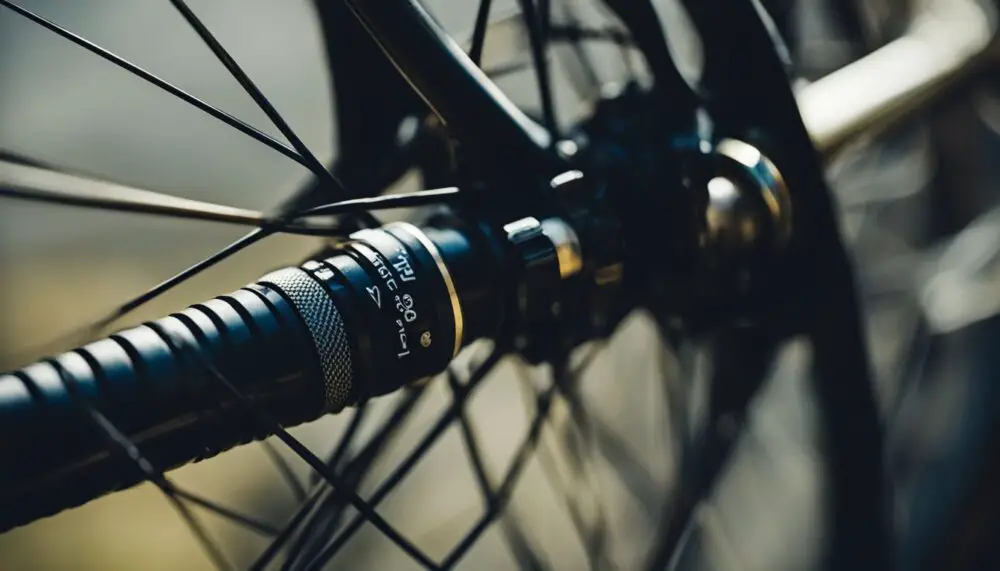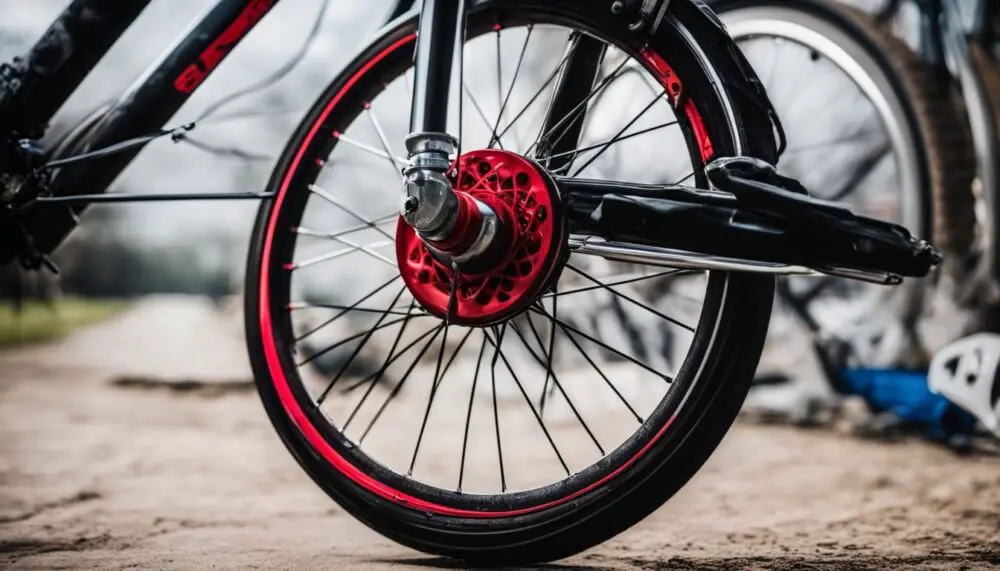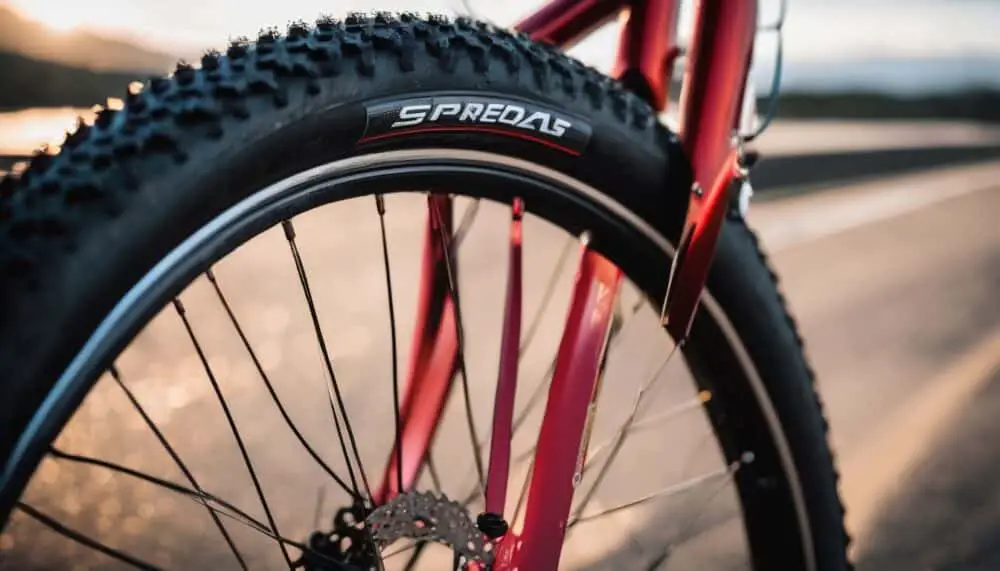Ever wondered why there are different types of valves on bike tires? The two common types are Schrader and Presta, with their unique functions and differences. This blog will help demystify these valves, comparing their pros and cons to assist you in choosing what’s best for your bike tire needs.
Let’s get down to brass tacks and learn more about these nifty little components!
Key Takeaways
- Schrader valves are wider and commonly found on car tires and most bikes in the U.S., while Presta valves are narrower and mainly used on road bikes and high-performance bicycles.
- Schrader valves are more durable, easier to inflate, and compatible with a wide range of pumps. whereas Presta valves are lighter, require a smaller hole in the rim, have better air retention, and can handle higher tire pressures.
- Schrader valves may require adapters for certain rims or pumps designed for Presta valves. They are also more prone to damage from impact or debris. On the other hand, Presta valves can be bent easily if not handled carefully and require specific tools for inflation.
- To choose the right valve for your bike tires, consider the type of inner tube or tire you have – standard tubes with Schrader valves or thinner ones with Presta valves. Match the correct valve type to ensure proper inflation.
Understanding Schrader and Presta Valves

Schrader valves are commonly found on car tires and have a spring-loaded check valve that allows air in when the pin is pressed. Presta valves, on the other hand, are narrower and typically found on bike tires, featuring a threaded outer wall and a lockring to secure it in place.
What are Schrader valves?
Schrader valves are found on car tires and most bikes in the U.S. They are short and fat, much wider than Presta valves. Inside a Schrader valve is a core that sits inside its threaded outer part.
Many people like these valves because they are strong and do not break easily.
What are Presta valves?
Presta valves are what you find on most bikes. They’re long and slim, with a smaller hole than the Schrader type. To pump air into a tire with a Presta valve, you have to unscrew the tiny nut at its top.
The inner tube holds this valve tightly shut until it’s unlocked.
These valves have an outer wall that is threaded. Inside, there is another part called the valve core. You can use adapters to make these work like Schrader valves if need be. This might come in handy when using pumps meant for car tires or at gas stations.
Differences between Schrader and Presta valves
Schrader and Presta valves are both critical components of your bike’s tire setup, but they serve different purposes and have distinct characteristics. Below is a comparative table illustrating the key differences between these two types of valves.
| Schrader Valves | Presta Valves | |
|---|---|---|
| Appearance | Shorter and thicker | Longer and slimmer |
| Common Usage | Used with both automobiles and bicycles | More commonly seen on road bikes and high-performance bicycles |
| Diameter of Valve Stem | 8mm | 6mm |
| Durability | More durable and less prone to damage | Less durable compared to Schrader valves |
| Hole Requirement | Requires a larger diameter hole | Requires a smaller diameter hole |
Understanding these subtle differences will enable you to make an informed decision when selecting the appropriate valve for your bike tires.
Pros and Cons of Schrader Valves

Schrader valves have several advantages, including their durability and compatibility with most air pumps. However, they also have some disadvantages such as being heavier and requiring a larger valve hole on the rim.
Advantages of Schrader valves
Schrader valves have several advantages for cyclists:
- Easy inflation: Schrader valves are commonly found on car tires, making them convenient because they can be easily inflated at gas stations or with air compressors.
- Better seal: Schrader valves create a tight seal based on the pressure inside the tube or tire, reducing the likelihood of air leakage.
- Durable design: Schrader valves are known for their durability and resistance to damage, making them suitable for rough terrain and off-road biking.
- Compatible with various pumps: Most bike pumps are designed to work with Schrader valves, making it easier to find a pump that works for your bike tires.
- Wide availability: Schrader valves are commonly used in many types of bicycles, including mountain bikes and city bikes, ensuring that replacement parts are readily available.
Disadvantages of Schrader valves
Schrader valves have some disadvantages that cyclists should consider:
- Incompatibility with certain rims or the need for adapters due to their larger size.
- Higher risk of damage or breakage due to exposed valve stem.
- More prone to damage from impact or debris because of their larger size.
- Require more force to inflate or deflate compared to Presta valves.
- Not as commonly used in high – performance or road cycling.
- Considered less efficient for maintaining tire pressure compared to Presta valves.
Pros and Cons of Presta Valves
Presta valves have several advantages, including their lightweight design and compatibility with high-pressure tires. However, they can be more prone to air leakage and require a separate adapter for inflation.
Advantages of Presta valves
Presta valves have some advantages over Schrader valves. Here’s why many cyclists prefer Presta valves:
- Lightweight: Presta valves are lighter, which means they add less weight to your bike compared to Schrader valves.
- Smaller hole: Presta valves require a smaller hole in the rim, allowing you to use narrower rims or carbon rims without compromising strength.
- Easier inflation: The locknut on the base of Presta valves holds the valve against the rim, making it easier to inflate flat tires. You don’t have to hold the valve in place like with Schrader valves.
- Better air retention: Presta valves hold air more effectively and don’t degrade as quickly as Schrader valves, so you won’t have to constantly check and pump up your tires.
- Higher pressure capability: Presta valves can hold more pressure and do it more reliably because they are sealed tightly by the air pressure itself. This is especially important for road cyclists who need high tire pressures.
Disadvantages of Presta valves
Presta valves have some disadvantages that cyclists should be aware of:
- Fragility: Presta valves are more delicate compared to Schrader valves. They can easily get bent or damaged, especially if not handled with care.
- Tools and Accessories: Using a Presta valve requires specific tools and accessories. Cyclists need a pump with a Presta-compatible head, as well as an adapter if they are using a pump designed for Schrader valves. This extra equipment can be inconvenient and adds to the cost.
- Lack of Check Valve: Unlike Schrader valves, Presta valves do not have a check valve built into them. This means that air can escape from the tire when attaching or removing the pump, causing a loss of pressure.
- Smaller Hole Size: Installing a Presta valve on a bicycle rim requires drilling a smaller hole compared to fitting a Schrader valve, which most bikes already have. This may limit compatibility with certain rims and make it harder to find replacement tubes.
- Compatibility Issues: Presta valves are not commonly found in gas stations or car tire pumps, making it difficult to inflate tires while on the road if you don’t have access to a dedicated bike pump.
Choosing the Right Valve for Your Bike Tires
To choose the right valve for your bike tires, you need to consider the type of inner tube or tire you have. If you have a standard tube with a Schrader valve, make sure your pump has a Schrader fitting.
These valves are wider and shorter than Presta valves and are commonly found on mountain bikes and some city bikes.
On the other hand, if you have a Presta valve, which is thinner and longer with a small knob at the top, you’ll need to use a pump that is compatible with Presta valves. Presta valves are specifically made for bicycles and can handle higher air pressure.
They are often found on road bikes and some high-performance mountain bikes.
If you’re unsure about what kind of valve your bike uses, check the rim or wheel model as it will usually indicate which valve type is required. It’s important to match the right valve to your inner tube or tire to ensure proper inflation and prevent any air leakage.
In conclusion, knowing whether you have a Schrader or Presta valve will help you choose the appropriate pump for inflating your bike tires correctly. Remember to double-check that your pump has the correct fitting before pumping air into your tires!
Conclusion
In conclusion, understanding the difference between Schrader and Presta valves is important for cyclists. While Schrader valves are more common and easier to use, Presta valves offer higher performance and can handle higher tire pressures.
Depending on your bike and needs, choosing the right valve type will ensure proper inflation and a smoother ride. So next time you’re pumping up your tires, remember to consider which valve type is best for you.
Happy cycling!
FAQs
1. What are the types of bike tire valves?
The main types of bike tire valves are Presta and Schrader valves.
2. How do Presta and Schrader valves differ?
Presta tube has a thin, long design with a valve lockring, while the Schrader tube is thick with an inner pin that controls airflow.
3. Can I use any pump for my bike tire?
Not every pump head fits both Presta and Schrader valves. You’ll need a pump that caters to your valve type – either a Presta compatible pump or a Schrader-only pump.
4. Is one type better than the other?
It depends on your wheel or rim model and desired air pressure. Both have their benefits; modern Presta valves work well in high-pressure systems, while Schrader fittings offer ease of use due to their spring-loaded check valve design.
5. Do these valve types work with tubeless tires?
Yes! You can find both Tubeless Presta tubes and Tubeless Schrader systems, excellent for maintaining the desired air pressure without any bicycle tubes involved!
6. Is it possible to add sealants or extenders to these valve types?
Absolutely! Adding tire sealant through the same valve helps prevent leaks if the tire starts leaking air; also, adding valve extenders enables proper inflation even on deep rims.




